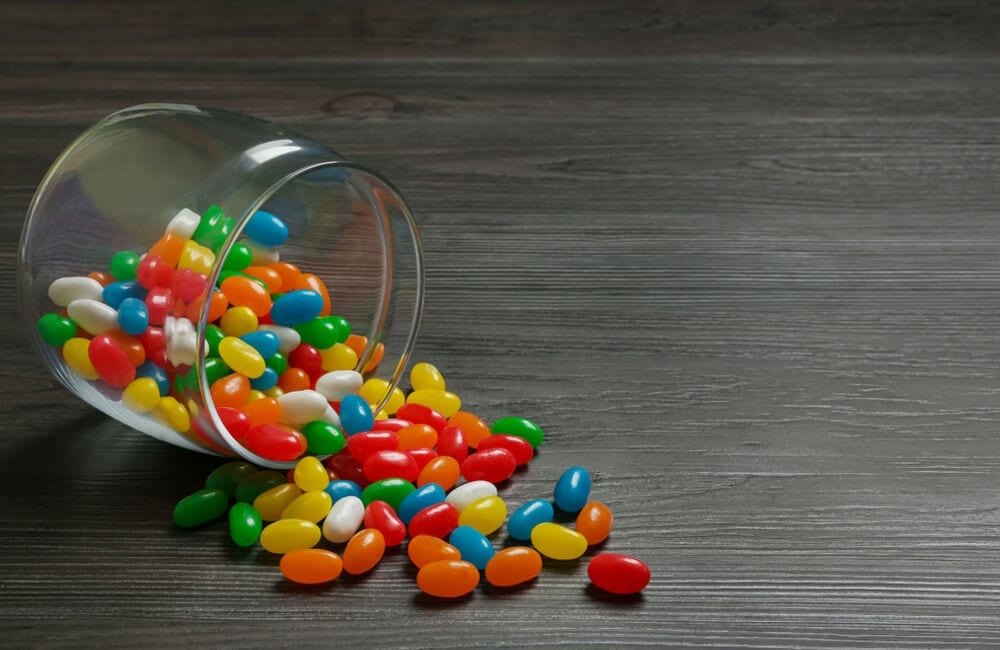These Toxic Food You Wouldn't Really Eat If You Knew Their Ingredients.
The agri-food industry continues to grow at a breakneck pace, with manufacturers and brands launching new products every day. Trade is booming, with hypermarket and supermarket sales more than doubling over the past 30 years in Europe alone.
By YEET MAGAZINE Updated 0118 GMT (0918 HKT) October 2, 2021

Chewing Gum © Lizardflms / Shutterstock.com
The agri-food industry continues to grow at a breakneck pace, with manufacturers and brands launching new products every day. Trade is booming, with hypermarket and supermarket sales more than doubling over the past 30 years in Europe alone.
Consumers appreciate good, inexpensive products, but do they always know what exactly is in the products they eat? Whether it's beaver secretions or sheep sebum in chewing gum, there are plenty of ingredients that advertisements will never mention.
1. Bean candies
Company / Brand: Jelly Belly and others
Ingredient: Shellac
The reasons shellac is known to the general public vary depending on the products used. It is indeed present in nail polish as in furniture varnish ... It is also used in gel candies to give them that shiny and attractive appearance. This should put you off already, but it's not over yet.

Jelly Beans © New Africa / Shutterstock.com
Shellac actually comes from a female bug that feeds on tree sap. These little critters are harvested, processed, and eventually end up in many confectionery products, like those from the Jelly Belly brand and many more that you can find in stores like Walmart.
2. Sliced bread in bag
Company / brand: Grupo Bimbo and others
Ingredient: L-cysteine
There was a time (yes, it dates) when sliced bread was just a dream. People had to bake their own bread or buy it straight from the bakery, but these days it's a product that many households have in their cupboards. However, there is a reason why freshly baked bread only lasts a few days while bagged bread can stay for weeks.

Packaged Bread © CGN089 / Shutterstock.com
This reason is called L-cysteine, which is not just an ordinary preservative. It is certainly natural, but it is not better. It actually comes from human hair. According to Disney's Vice , the most common source is hair salons in China. The hair is swept, dissolved in acid, L-cysteine is extracted, direction the bakery to be incorporated into the bread.
3. Cheese
Company / Brand: Schuman's Fairfield and others
Ingredient: Goat rennet coagulant
Cheese is an extraordinary product that generates considerable sums of money for many companies. It's one of the most popular and commonly purchased foods around the world, but have you ever wondered what the hell is in it?

Cheese © MaraZe / Shutterstock.com
Cheese is often at the top of our shopping list when we go to Intermarché, but what if we told you that the cheese was made from a coagulant from the belly of a goat? , a calf or a lamb? What is even more disturbing is that the animal in question is usually a baby, as it must still be breastfed by its mother for the right enzyme to be present.
4. Packaged / vacuum-packed meat
Company / Brand: Gifi and others
Ingredient: Carbon monoxide
Large families often buy large amounts of packaged meat when shopping. One kilogram of ground meat can make several meals and it is an economical way to feed everyone. However, even by choosing top quality meat, you may be consuming something other than protein.

Packaged Meat © Sergey Ryzhov / Shutterstock.com
Meat processing plants actually use carbon monoxide, which allows meat to retain that red color that it wouldn't normally have after being exposed to the air. Granted, we're talking about a small amount that doesn't alter the taste, but it's a double-edged sword because even if the meat starts to perish, it will keep that red color for longer. You should therefore be vigilant when browsing the butcher's section of stores in the future.
5. Beer
Company / brand: Various
Ingredient: Fish glue (Ichtyocolle)
Beer has often been universally recognized as a popular commodity, regardless of dietary preferences. Sure, some people are allergic to certain ingredients, but did you know vegetarians should be wary of them too?

Beer © Syda Productions / Shutterstock.com
A sneaky little ingredient called isinglass is used in the brewing process. It helps keep the color clear and attractive, but where does it come from? It is actually a product made from the bladder of fish. The beer is a bit more bitter now, isn't it? Note, however, that brewers like Budweiser do not use this ingredient in their products.
6. Chewing gum
Company / Brand: Wrigley's and others
Ingredient: Lanolin or sebum
Chewing gum has been around for decades. Some find this habit of constantly chewing disgusting, but it would be worse if they knew exactly what was in them. To make the chewing gum pleasant and soft and give it that famous texture, manufacturers often use lanolin.

Chewing Gum © Billion Photos / Shutterstock.com
Lanolin may sound harmless, but it's actually something that oozes out of sheep's wool. The human equivalent of this substance is sebum, which is actually a kind of oil that comes out of our pores. So, the next time you're tempted to buy a pack of chewing gum from Amazon , think twice and remember what's in it. Advertising
7. Marshmallows / Marshmallows
Company / Brand: Rocky Mountain and others
Ingredient: Hides and bones of pigs and cows (gelatin)
Most of us are aware that gelatin is a commonly used ingredient in many products, especially some candies. But did you know that cow and pork bones are also used in making marshmallows?

Marshmellows © Oksana Lyskova / Shutterstock.com
The next time you're tempted to put a bunch of them in your shopping car, it might be good to remember what those sweet, chewy little balls really are in. While the sugar may make you forget you're eating boiled animal carcass extracts, make no mistake - they are indeed present, even if you don't smell them.
8. Worcestershire sauce
Company / Brand: Lea & Perrins
Ingredient: Anchovies fermented in vinegar
When it comes to anchovies, the world falls into two categories: those who love them and those who hate them. This salted fish is very divisive in terms of taste, but its rich flavor makes it a staple ingredient used in some products, even if you don't realize it.

Worcestershire Sauce © Ralf Liebhold / Shutterstock.com
Worcestershire sauce is mostly popular in Britain, but it is also available in the United States. Brands like Lea & Perrins actually use anchovies that have been fermented in vinegar for over a year and a half. This is probably what explains its salty taste and its very pronounced flavor.
9. Canned mushrooms
Company / brand: Various
Ingredient: Maggots and moths
You won't be taught anything by telling you that mushrooms grow in the ground. Most of the time, they are found delicious, but things are a bit different when it comes to canned mushrooms. It's not so much about the mushrooms themselves, but what can be added to them in the box.

Canned Mushrooms © Lyudmila Mikhailovskaya / Shutterstock.com
In the United States, the FDA actually allows a number of maggots in cans. Thus, she considers that 30 maggots / 75 mites per box do not present any danger to the organism. This doesn't necessarily mean that the ones you bought from Intermarché contain it every time, but it does send chills down your spine knowing that it's legally allowed.
10. Coffee cream
Company / Brand: Nestlé, Coffee-Mate
Ingredient: Oil
There would be a lot to say about black coffee and a great cup of coffee. If you prefer creamy coffee, there's nothing to complain about either - it all depends on what kind of cream you're using. Some non-dairy creams are indeed rather… interesting.

Coffee Creamer © ThamKC / Shutterstock.com
Liquid Coffee-Mate uses water, syrup solids, and soybean oil to achieve the same consistency as milk. In short, it doesn't really make your coffee taste or creamy, but rather a good dose of oil to sweeten the taste. You won't find this at Starbucks. obviously.
11. Jell-O
Company / Brand: Kraft Foods, Jell-O
Ingredient: Cow and pig skins (gelatin)
Jell-O products can be consumed at different times, either as a dessert or as an after-school snack. They are so popular and are part of pop culture history, but when you think about what's in them, it can mar our fondest childhood memories.

Jell-O © calimedia / Shutterstock.com
Gelatin is the main ingredient in Jell-O, the rest being sugar and flavors. In other words, these are boiled animal carcasses that… let's stop there.
12. Caesar salad
Company / brand: Various
Ingredients: Anchovies
If you're a vegetarian, ordering a salad at a restaurant might seem like a low-risk choice. After all, there's no meat in a Caesar salad if you ask for it without chicken, is there? This is true in theory, since salad is a vegetable, but it is not always the case.

Caesar Salad © nadianb / Shutterstock.com
One of the most popular things about this type of salad is the sauce, but this isn't always vegetarian. In fact, many ready-made Caesar salads contain anchovy-based dressings. Companies like Kraft also recognize that their sauces contain fish allergens .
13. Parmesan
Company: Kraft and other
Ingredient: Cellulose / wood pulp
It's hard to imagine that the tasty cheese you sprinkle on your pasta contains anything other than dairy, and yet… In fact, most brands of Parmesan on the market incorporate wood pulp in their composition.

Grated Parmesan © Nitr / Shutterstock.com
These are not rumors or speculations, but an openly FDA approved secret. Wood pulp, also known as cellulose, is a natural ingredient that has been proven to be an anti-caking agent. It is not only Parmesan that has it, but many grated cheeses, because it prevents the formation of lumps.
14. Orange juice
Company / Brand: Del Monte and others
Ingredient: Ethyl butyrate
If you can't do without your glass of orange juice when you wake up in the morning, maybe you should read on. As “freshly squeezed” a brick orange juice may sound, many different brands use chemicals to add flavor.

Orange Juice © Niloo / Shutterstock.com
For example, ethyl butyrate is commonly used to incorporate a significant amount of artificial flavors into orange juice. Fresh juice does indeed have to be preserved in one way or another and it often loses its flavor in the process. By adding such an artificial compound to the mixture, manufacturers are able to preserve and refine its taste.




